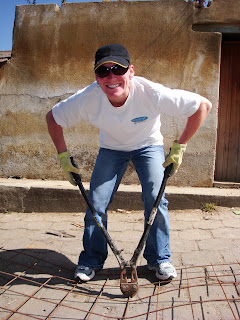



 De Casas A Hogares
De Casas A Hogares (From Houses to Homes) has a mission: to construct a future for Guatemalan families and communities "by building lasting, healthy homes, improving access to health care and education, and inspiring participation between the poor and civil society." And to date, they are on track for doing so, having already:
- Constructed 300 new homes providing housing for 1,780 people;
- Repaired an additional sixteen homes, making them liveable and providing housing for 72 people;
- Provided safe and efficient stoves for 35 families;
- Provided school supplies for 96 students in 2009 - but cumulative, have helped to educate a total of 1,001 children by paying for their registration and/or school supplies.
On Tuesday we joined From Houses to Homes to join them in their efforts. We arrived to their headquarters, a gang of disheveled and slightly rowdy work horses. We split up by casitas (or our houses) into the back of two pickup trucks...so yes, if you're thinking, "Does that mean they were in the
back of the truck?" you are correct...that's how the Guatemalans do it, that's how we do it :)
We drove about ~25 minutes, a beautiful winding road uphill, the wind blowing gently, the city becoming smaller...the vista laid out before us in all its splendor (seriously, think "Gone with the Wind" it was that green and lush....but much more savage in its application). We arrived to Santa Maria de Jesus, a decidedly different community than Antigua...and vastly contradictory from what one might expected given the drive. Santa Maria is more typical in its poverty, seen in its provisional houses made of corrugated metal siding, scraps of wood, and plastic bags as siding. The floors are made of dirt and most have leaky roofs.
Families are often selected by community vote, where the village will nominate the family they think is most deserving. From Houses to Homes then visits the family over several months to see how they are actually living. The only requirement to receive a home is to be very poor and to prove ownership of the property.
Today, our two groups went to two different sites to pour concrete floors. The process is quite different here as you are likely already imagining:
Step 1: Bring all of your own supplies: shovels, buckets, rocks, cement mix, food, toilet paper...you know, the essentials :)
Step 2: Even out the dirt floors by hauling out in buckets
Step 3: Move sands, cement, and rocks into one big pile
Step 4: Move said pile into two piles
Step 5: Move said two piles into one pile again (time consuming but you could definitely see the utility in this method when you do not have a mixer)
Step 6: Add water
Step 7: The assembly line begins: we had mixers, carriers, and smoothers...all technical terms of course
Step 8: Step back and admire - concrete floors completed.
In summary:
40 wheelbarrows of sand + 20 bags of cement + 10 wheelbarrows of rocks + as much water as needed + 4 Guatemalans + 15 even more disheveled gringos = 2 homes with flooring (4 floors in total) and many achy body parts...but ah! the memories :)
And really, being this physical with shovels and buckets of cement can be akin to being a PT...think about it...




















































